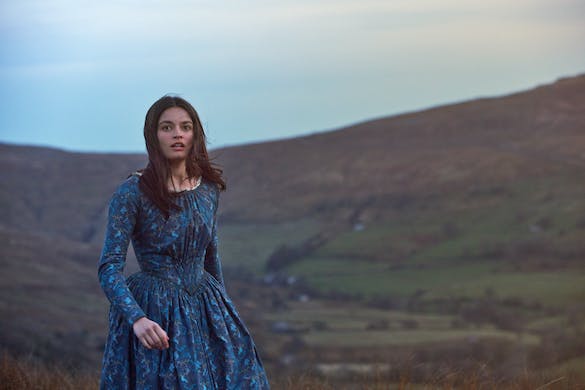Was the Author of ‘Wuthering Heights’ Something of a 21st Century Hipster?
‘Emily’ strains to offer a vivid depiction, but no matter how strange and anxiety-ridden Emily Brontë may have been, it’s just too far-fetched to believe she would have indulged in an opiate and textual body art.

Where do stories come from? This question is central to the new movie “Emily” and its take on how Emily Brontë came to write her one novel, the wild and weird “Wuthering Heights.”
Director Frances O’Conner takes the few definitive facts known about Brontë’s short life — sisters Charlotte and Anne, the dissolute brother, the trauma of their mother’s early death, the reverend father, the Yorkshire upbringing — and adds a thwarted love affair and more to the mix to create a passionate if not entirely plausible origin story for the classic book.
Brontë’s alienation from her family and her father’s way of thinking is established adroitly in the movie’s opening scenes. After a framing opening scene in which Emily is ill and thinks back over the recent past, we see her alone in a field formulating a tale about a captain and a lady. Later, we witness her smirking in a church as her father conjures up fire and brimstone from the pulpit.
This sermon scene is important, too, for it introduces the character of the new curate, William Weightman. He is handsome, poetic, and single, so naturally any viewer might guess where the story is headed, especially as Brontë is taken with him, albeit reservedly.
Emma Mackey portrays Emily in these early scenes as retiring and doubtful, yet there are moments reflecting a more determined, mischievous, even mystical personality. In a stunning, candlelit scene inspired by, according to the press notes, an anecdote written by the Reverend Brontë, Emily evokes her deceased mother while behind a porcelain mask, with her sisters, brother, and William looking on at first in horror, then in belief and entreaty, and finally back to horror as fierce winds force open a door.
Yes, this all sounds like something from a Gothic novel, as if taken from “Wuthering Heights” itself. Indeed, there are other scenes recreating the haunting atmosphere of Gothic fiction or directly referencing Brontë’s novel, such as when Emily and her brother peep through the window of a nearby house, as Heathcliff and Catherine do in the novel. This “spot the inspiration” element continues the movie’s exploration of storytelling, yet it is the film’s bolder speculations that take the term “inspired by actual events” to another, lower level.
The film posits that Brontë took opium and got a tattoo, spurred on by her brother. These conjectures come off as ridiculous when one considers the Victorian era in which Brontë lived and her social status. No matter how strange and anxiety-ridden she may have been, it’s just too far-fetched to believe she would have indulged in an opiate and textual body art, with these plot points revealing the filmmakers’ preference for contemporary culture over mid-19th century reality.
As Brontë, Ms. Mackey displays an intensity, intelligence, and acute sensitivity in keeping with our notion of how the writer might have lived. She also has an amazing face — a cross between Eva Green, Margot Robbie, and Kiera Knightley — with its wide features and silken composition outlined in raven hair that is rarely hidden under a bonnet like that of the other female characters. Alexandra Dowling as Charlotte Brontë, who goes on to write “Jane Eyre,” rivets with her composure and confidence, leaving this viewer wishing that there were more scenes addressing their sibling rivalry and exchange of ideas.
Both Fionn Whitehead as Emily’s brother and Oliver Jackson-Cohen as her conflicted lover effectively convey their admiration of and influence over Brontë, but even together they make for a weak-tea version of what the filmmakers intend to be the composite character of the novel’s Heathcliff. Nothing in their characters’ personalities indicate a tempestuous nature or vengeful proclivity akin to the iconic character.
Having starred in the 1999 film version of “Mansfield Park,” director and writer O’Conner can’t seem to get past the gentility of Jane Austen’s oeuvre in order to reach the stormy, cruel, all-consuming heart of Brontë’s masterwork.
What we are left with is a story about the makings of an iconic book where the details don’t add up to more than your run-of-the-mill melodrama. As in many a melodrama, music must do much of the heavy lifting, and Abel Korzeniowski’s string section careens up and down while his piano occasionally flits romantically or plods despondently.
Ms. O’Conner best employs his hypnotic strings during setpieces in which scenes play out without audible words, despite the actors sometimes mouthing dialogue. Appropriately, these sequences come closest to mirroring the heavy mood of Gothic novels and the rise-and-fall rhythm of Brontë’s writing. They also subtly suggest a rich source for some stories: lovely music.

